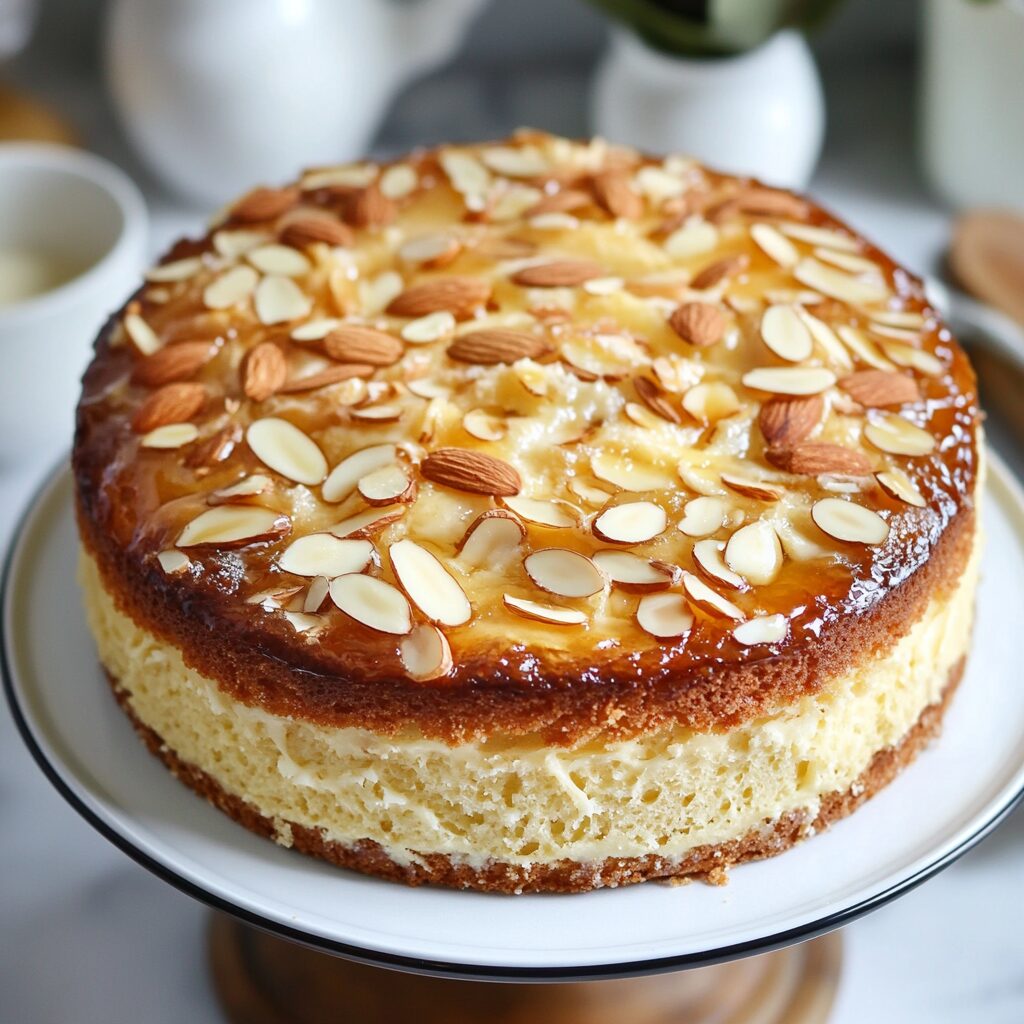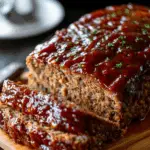The German Bee Sting Cake, or Bienenstich, is a beloved dessert that combines the comforting qualities of a yeasted dough with the richness of a creamy vanilla filling. Topped with a glossy, honey-infused almond layer, this cake offers a delightful contrast of textures and flavors.
Traditionally enjoyed with afternoon coffee, Bienenstich has a storied history dating back to the early 20th century in Germany. Its name, “Bee Sting,” is said to originate from a legend where bakers defended their town by throwing beehives at invaders, leading to the cake’s sweet and sticky reputation. Whether for a special occasion or a casual treat, this cake brings a taste of German heritage to your table.
Full Recipe
Ingredients:
For the Dough:
-
2 1/4 cups (270g) all-purpose flour
-
2 tablespoons (25g) granulated sugar
-
1 1/2 teaspoons instant yeast
-
3/4 teaspoon salt
-
2 large eggs, at room temperature
-
1/4 cup (57g) lukewarm water
-
4 tablespoons (57g) unsalted butter, at room temperature
For the Almond Topping:
-
1/4 cup (50g) granulated sugar
-
1/2 cup (125g) honey
-
9 tablespoons (125g) unsalted butter
-
2 cups (150–200g) sliced almonds
-
1/2 teaspoon vanilla extract
For the Cream Filling:
-
1 1/2 cups (340ml) half-and-half
-
1/2 cup (90g) granulated sugar
-
1/2 vanilla bean, split and scraped
-
2 large eggs, at room temperature
-
1 large egg yolk, at room temperature
-
3 tablespoons (30g) all-purpose flour
-
1/4 teaspoon (2g) salt
-
1 cup (226ml) heavy whipping cream
Directions:
-
Prepare the Dough:
-
In a large bowl, combine flour, sugar, instant yeast, and salt.
-
Add eggs and lukewarm water; mix until a dough forms.
-
Knead in softened butter until smooth and elastic.
-
Cover and let rise in a warm place for 1 hour or until doubled in size.
-
-
Prepare the Almond Topping:
-
In a saucepan, melt butter over medium heat.
-
Stir in sugar and honey; bring to a boil.
-
Remove from heat and stir in sliced almonds and vanilla extract.
-
Set aside to cool slightly.
-
-
Prepare the Cream Filling:
-
In a saucepan, combine half-and-half, sugar, and vanilla bean seeds.
-
Bring to a simmer over medium heat.
-
In a bowl, whisk together eggs, egg yolk, flour, and salt.
-
Gradually add hot half-and-half mixture to egg mixture, whisking constantly.
-
Return mixture to saucepan and cook over medium heat, whisking until thickened.
-
Remove from heat and let cool to room temperature.
-
In a separate bowl, whip heavy cream to soft peaks.
-
Gently fold whipped cream into cooled custard until well combined.
-
-
Assemble the Cake:
-
Preheat oven to 350°F (175°C).
-
Punch down the risen dough and roll it out to fit a greased 9-inch round cake pan.
-
Pour almond topping over the dough, spreading evenly.
-
Bake for 25–28 minutes, or until golden brown.
-
Remove from oven and let cool completely.
-
-
Fill the Cake:
-
Once the cake has cooled, slice it horizontally to create two layers.
-
Spread cream filling evenly over the bottom layer.
-
Place the top layer on top and press gently to adhere.
-
Prep Time: 90 minutes
Cooking Time: 50 minutes
Total Time: 3 hours 20 minutes
Kcal: Approximately 400 kcal per serving
Servings: 12
The Sweet Legacy of German Bee Sting Cake (Bienenstich)
The German Bee Sting Cake, known in its homeland as Bienenstich, is one of Germany’s most iconic desserts. It’s a cake that tantalizes the senses with a beautiful contrast between fluffy, slightly chewy yeast dough and a luxuriously smooth vanilla cream filling — all crowned with a caramelized honey-almond topping. Its allure lies not only in its flavor but also in the romantic folklore and cultural significance that have helped it endure through generations.
A Cake Born from Legend
The origins of the Bee Sting Cake are steeped in legend. According to the most popular tale, this dessert was created in the 15th century when bakers in a German village used beehives as a defense weapon against invading forces. After successfully thwarting the attack, the bakers celebrated by crafting a cake sweetened with honey — hence the name Bee Sting Cake. Though the story’s historical accuracy is debated, it adds a charming layer of folklore that enhances the cake’s nostalgic appeal.
Cultural Importance in German Baking
In Germany, the Bienenstich holds a place of honor in bakeries and home kitchens alike. It’s a common fixture at Kaffee und Kuchen — the cherished German tradition of coffee and cake in the afternoon. Often served during family gatherings, holiday celebrations, or casual Sunday get-togethers, it’s a cake that brings people together.
Unlike many Western cakes that use sponge or butter bases, Bienenstich starts with a yeast-based dough. This unique foundation reflects Germany’s baking traditions, where enriched doughs are often used for both sweet and savory treats, including Stollen, Kuchen, and Brotchen.
What Makes Bienenstich Unique
One of the most distinctive characteristics of Bienenstich is its use of a honey-almond topping that caramelizes in the oven. When baked, the topping turns golden and crisp, offering a nutty crunch that balances the smooth cream filling. This balance of textures — soft dough, creamy center, and crunchy top — is part of what makes the Bee Sting Cake so addictive.
Another unique aspect is the cake’s versatility. It can be served chilled or at room temperature, making it an excellent make-ahead dessert. The yeast base also adds a subtle tang and structure, providing a pleasant contrast to the sweet and rich topping and filling.
Modern Variations of Bee Sting Cake
While the traditional recipe includes a custard or pastry cream filling, modern versions have adapted to fit different tastes and dietary needs. Here are some popular variations:
-
Whipped Cream & Custard Combo: Some recipes incorporate whipped cream into the pastry cream for a lighter, mousse-like texture.
-
Buttercream Filling: A denser, richer version that’s particularly popular in bakery settings due to its firmness and longevity.
-
Lactose-Free or Vegan Versions: Using plant-based milk, vegan butter, and agar or cornstarch-based fillings allows this cake to be enjoyed by those with dietary restrictions.
-
Mini Bienenstich: Instead of one large cake, the dough can be baked in muffin tins to create individual servings — ideal for events or picnics.
-
Fruit-Infused Creams: Strawberry, raspberry, or lemon curd additions to the cream filling give the cake a seasonal twist.
Tips for Making the Perfect Bienenstich
Baking a Bee Sting Cake at home is a rewarding endeavor, but attention to detail is crucial to achieving bakery-quality results. Here are some tried-and-true tips:
-
Use Fresh Yeast or Quality Instant Yeast: The dough relies on proper leavening to rise and create a soft, airy base.
-
Allow Proper Proofing Time: Don’t rush the rise. The dough needs to double in size to develop its soft texture.
-
Be Cautious with the Almond Topping: Apply the topping carefully so it doesn’t sink into the dough. Letting it cool slightly before spreading can help control its texture.
-
Cool Completely Before Slicing: To prevent the cream from melting or leaking, make sure both the cake and filling are completely cool before assembly.
-
Use a Serrated Knife to Slice: The sticky topping can make slicing tricky. A serrated knife or a hot, wet knife can create cleaner cuts.
Why It’s a Showstopper for Any Occasion
Bienenstich Cake isn’t just for special occasions — although it certainly shines during them. Whether you’re preparing it for a family reunion, a brunch gathering, or simply as a weekend treat, this cake captures attention with its glossy top and layered elegance.
Its ability to be made ahead, frozen, or refrigerated for short periods also makes it practical. The structure holds well, and the flavors actually improve as they meld together over time.
Additionally, the cake serves as a wonderful conversation starter. Guests unfamiliar with German desserts are often curious about its name, and those who grew up with it find themselves flooded with memories of home.
Pairing Suggestions and Serving Ideas
-
Coffee and Espresso: The bitterness of coffee perfectly complements the sweetness of the almond topping and vanilla filling.
-
Sparkling Wine: If serving at a celebration, a glass of dry prosecco or sekt enhances the nutty notes.
-
Berries and Fresh Cream: For an elegant plate presentation, garnish with raspberries, strawberries, or blueberries and a dollop of whipped cream.
-
Brunch Boards: Cut the cake into small squares and include it as a sweet option on a German-style brunch board with meats, cheeses, and fresh bread.
Nutritional Considerations
As indulgent as it is, Bienenstich can be adjusted for health-conscious eaters. Reducing the sugar slightly or using light cream alternatives can help moderate its richness. You can also opt for whole-grain flour or plant-based options without compromising too much on flavor.
Keep in mind that due to its cream filling, refrigeration is necessary to maintain freshness and food safety — especially in warmer climates.
The Enduring Appeal of Bienenstich
Few cakes offer the combination of rich history, cultural value, and textural complexity quite like the Bee Sting Cake. With its luscious cream filling, crunchy almond crown, and fluffy yeast base, it’s a masterpiece of contrasts that feels both rustic and refined.
In a world of rapidly modernizing desserts, the Bienenstich remains a testament to the timeless appeal of classic baking. It’s a slice of heritage that continues to evolve, with bakers around the world reinterpreting it for new audiences while staying true to its sweet roots.
Conclusion
The German Bee Sting Cake is more than a dessert — it’s a cultural artifact, a tribute to the art of traditional baking, and a joy to prepare and share. Whether you’re exploring European confections or rediscovering an old favorite, Bienenstich offers the perfect blend of history, flavor, and indulgence.
Its poetic name, legendary origin, and multilayered texture make it stand out in any collection of recipes. By learning how to make this cake, you’re not only mastering a dish — you’re also participating in a centuries-old story that celebrates ingenuity, resilience, and the pure pleasure of something sweet.






